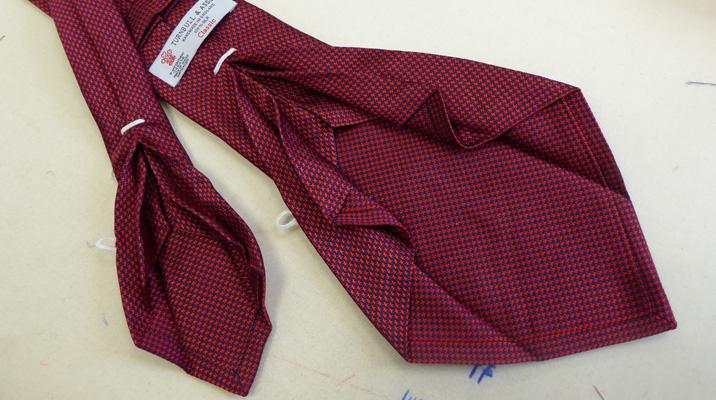The Seven-Fold Tie

With a thick, quality finish, a seven-fold tie is the pinnacle of luxury neckwear thanks to the abundant use of fine silk and the intensive manual labour required for each one.
They were first seen at the end of the 19th century pre-dating the use of interlining so many are still unlined and untipped in present-day productions. At Turnbull & Asser we still give every in-house tie a soft and wear-resistant lining, and use a precise method of self-tipping in seven-fold designs to ensure the accessory is made from one solid piece of silk.
The long and laborious process of creating a seven-fold tie means every piece is a work of art in itself. Each creation is hand-made over three and a half hours by a dedicated seamstress using 0.77m of fabric – taking ten times longer and using double the material than that of a traditional tie, though the final width is the same 9.5cm measurement.
OUR PROCESS

Once the cutter slices the silk into the larger seven-fold pattern the pieces are sewn together by a sewing machine – the only process done mechanically – and self-tipped before being passed onto the seamstress.


The lining is placed in the middle and pushed to the tip of the tie, then centralised.

The tie is folded into 9.5cm shape; each fold is done one at a time, being steamed and pinned to hold in place before sewing.

Once all the folds are in place, a bar tack is sewn into the lining and then a slip stitch is done by hand; the tie begins to take shape.


During the process of slip stitching, the tie loop is also attached by hand.


The iconic Turnbull & Asser label is placed between the loop and bar tack, and a Seven-Fold label is sewn to the underside of the blade.



The final step requires two extra-thick bar tacks to be sewn in, created by doubling over thread many times, before a button and scallop loop is sewn in to add stability. This process is what makes the seven-fold tie special and unique.

The final tie displayed with all its folds.


